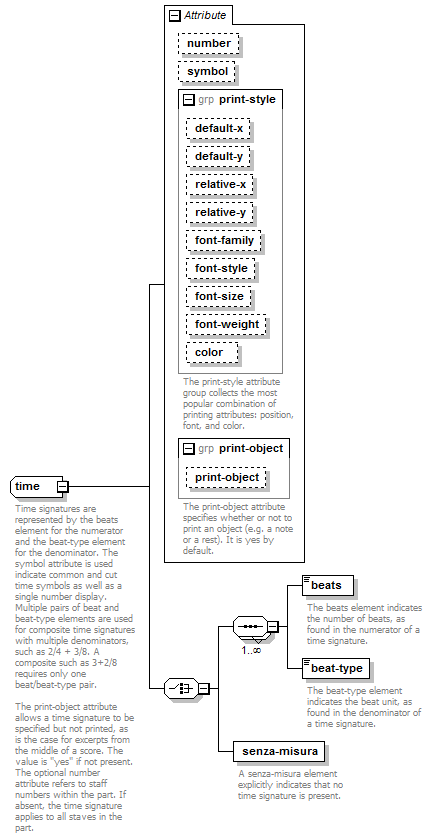<xs:complexType name="time">
<xs:annotation>
<xs:documentation>Time signatures are represented by the beats element for the numerator and the beat-type element for the denominator. The symbol attribute is used indicate common and cut time symbols as well as a single number display. Multiple pairs of beat and beat-type elements are used for composite time signatures with multiple denominators, such as 2/4 + 3/8. A composite such as 3+2/8 requires only one beat/beat-type pair. The print-object attribute allows a time signature to be specified but not printed, as is the case for excerpts from the middle of a score. The value is "yes" if not present. The optional number attribute refers to staff numbers within the part. If absent, the time signature applies to all staves in the part.</xs:documentation>
</xs:annotation>
<xs:choice>
<xs:sequence maxOccurs="unbounded">
<xs:element name="beats" type="xs:string">
<xs:annotation>
<xs:documentation>The beats element indicates the number of beats, as found in the numerator of a time signature.</xs:documentation>
</xs:annotation>
</xs:element>
<xs:element name="beat-type" type="xs:string">
<xs:annotation>
<xs:documentation>The beat-type element indicates the beat unit, as found in the denominator of a time signature.</xs:documentation>
</xs:annotation>
</xs:element>
</xs:sequence>
<xs:element name="senza-misura" type="empty">
<xs:annotation>
<xs:documentation>A senza-misura element explicitly indicates that no time signature is present.</xs:documentation>
</xs:annotation>
</xs:element>
</xs:choice>
<xs:attribute name="number" type="staff-number"/>
<xs:attribute name="symbol" type="time-symbol"/>
<xs:attributeGroup ref="print-style"/>
<xs:attributeGroup ref="print-object"/>
</xs:complexType> |
